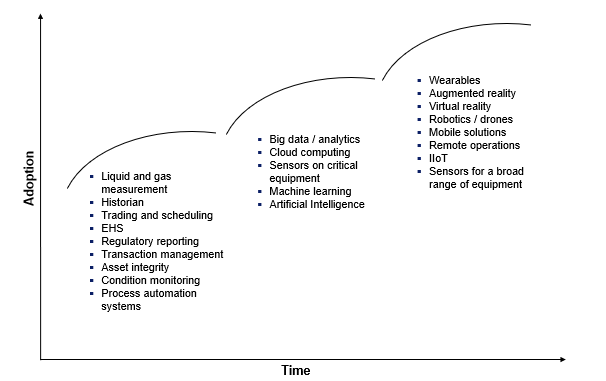
Stagnant oil prices have increased pressure on the oil and gas industry to improve operational efficiencies. Digital innovation provides a means to achieving a breakthrough in production performance, mitigating risks, increasing safety, and optimizing their workforce. Further innovation from OEMs and an openness and road map planning by operators are needed too fully realize digital transformation and the industrial internet of things (IIoT) in midstream. IIoT offers a lot of promises and is driving interest among both OEMs and operators.
Midstream companies have leveraged many digital components to manage pipelines, gathering systems, processing facilities, and storage facilities, but none have fully realized the benefits of undergoing a digital transformation. Existing digital equipment includes electronic flow metering, corrosion monitors, and accounting systems while full digitization will include the incorporation of big data, IIoT, artificial intelligence, virtual and augmented reality, and wearables. Falling cost of sensors and digital infrastructure means small and mid sized companies can achieve digital transformation as well. Continuous collaboration between OEMs and operators is key to realizing digital transformation as both should establish goals and address challenges along the way. OEMs must provide solutions which build upon existing assets while innovating for digital solutions of the future. With continuous collaboration, adoption of digital solutions will likely occur in three phases which is illustrated in Figure 1.

The Industrial Internet of Things is driving new innovations as well as acquisitions in the OEM market. OEMs have been expanding their IIoT capabilities through acquisitions and partnerships to better serve their customers. There has been a significant rise in consolidation in the market as vendors have shifted to a bundled service approach for their go-to-market strategies. offering full integrated solutions. Bundling services will provide fully integrated digital offerings and possibly lower overall costs.
Operators have also begun to adopt IIoT technologies. RasGas and Woodside adopted digital solutions for LNG to improve asset performance through predictive maintenance. BP and PEMEX are using IIOT to increase refinery automation and implement predictive maintenance. Gas processing plants and pipelines are a huge opportunity for IIoT technologies as it provides a means to increase operational efficiencies. We have seen companies such as DCP, which has a central control system, and Enlink which has hired a Chief Digital Officer, embrace the digital future and we expect other operators to follow suit.
ADI Analytics has been closely following digital trends and technologies in the oil and gas value chain as we have assisted startups with go-to-market strategies, identified opportunities for digital technologies, and have assessed operator initiatives and paint points of digital solutions.
-Brandon Johnson and Uday Turaga



















